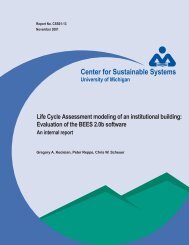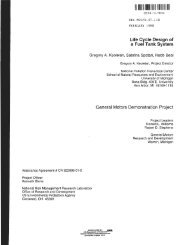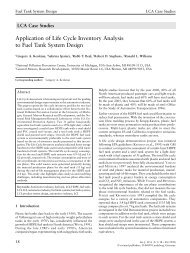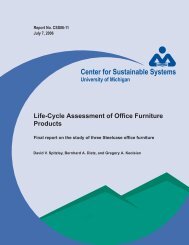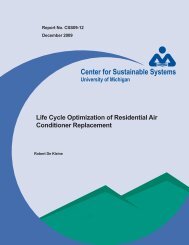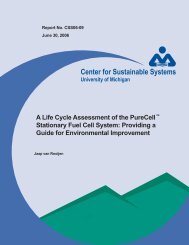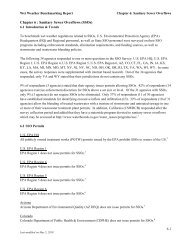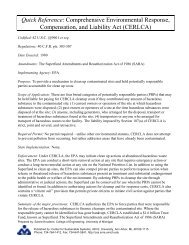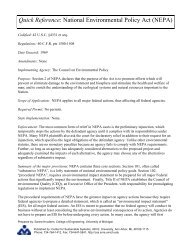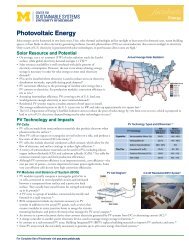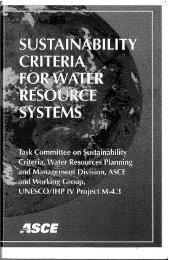Life cycle energy and environmental benefits of ge... - ResearchGate
Life cycle energy and environmental benefits of ge... - ResearchGate
Life cycle energy and environmental benefits of ge... - ResearchGate
Create successful ePaper yourself
Turn your PDF publications into a flip-book with our unique Google optimized e-Paper software.
M.C. Heller et al. / Renewable Energy 29 (2004) 1023–10421037<strong>and</strong>1456 g NO x /MWh for the residue/willow blend <strong>and</strong> the all-willow scenario,respectively (15% <strong>and</strong>14% system reduction relative to no c<strong>of</strong>ire, respectively).The model also predicts a roughly 6% reduction in particulate emissions with10% c<strong>of</strong>iring, all <strong>of</strong> which is realizedthrough reducedcoal mining operation (Fig. 4,Table 7). However, the model assumes that there is no chan<strong>ge</strong> in power plant particulateemissions with c<strong>of</strong>iring <strong>of</strong> biomass.C<strong>of</strong>iring biomass also provides significant reductions in mercury emissions.Metal analysis <strong>of</strong> willow biomass indicates an avera<strong>ge</strong> mercury content <strong>of</strong> 0.005mg/odkg [14] (Hg content not available for residue biomass). Assuming that allthe biomass-derived Hg volatilizes during combustion, a 10% c<strong>of</strong>ire <strong>of</strong> all willowwouldreduce the system air emissions <strong>of</strong> Hg by 8.4%. Contributions <strong>of</strong> mercuryfrom willow production are negligible. Note that there is a potential for biomass tocontain other heavy metals <strong>of</strong> concern. Metal content in the biomass is a function<strong>of</strong> metal concentrations in the soil where the crop is grown <strong>and</strong>tree uptakeefficiency [32,33].3.2. Dedicated willow biomass electricity <strong>ge</strong>neration in comparison with otherrenewablesTable 7 also contains the estimated emissions for dedicated willow biomass toelectricity system, using both direct-fired <strong>and</strong> gasification conversion technologies.In these scenarios, it is assumedthat willow biomass supplies all <strong>of</strong> the feedstock<strong>energy</strong> to the power plant. Emissions from the production <strong>and</strong> transportation <strong>of</strong>willow are combinedwith power plant emission factors containedin Table 5. Significantpollution prevention (relative to the current US electricity grid) is realizedwith biomass-<strong>ge</strong>neratedelectricity. The high net <strong>energy</strong> ratios demonstrate the fossil<strong>energy</strong> leveraging <strong>of</strong> a renewable <strong>energy</strong> source. For example, 13 units <strong>of</strong> electricityare <strong>ge</strong>neratedfor every one unit <strong>of</strong> fossil <strong>energy</strong> consumedacross the full life<strong>cycle</strong> <strong>of</strong> willow gasification.Comparisons with example LCAs <strong>of</strong> other renewable <strong>energy</strong> technologies revealthat biomass affords relatively similar levels <strong>of</strong> avoided pollution (Table 7). Biomassoutperforms BIPV from an <strong>energy</strong> perspective (as well as the closely correlatedglobalwarming potential) but does not score as well as wind<strong>ge</strong>neration. Itshould be noted, however, that these studies do not take into account the powerfluctuation <strong>of</strong> the different <strong>ge</strong>nerating systems. Both wind <strong>and</strong> solar are intermittentsources, while biomass permits continual base load<strong>ge</strong>neration.4. DiscussionC<strong>of</strong>iring biomass with coal provides numerous <strong>environmental</strong> <strong>benefits</strong>. While theupstream <strong>energy</strong> consumedin growing or processing <strong>and</strong>transporting biomassroughly balances the reduced consumption from mining, processing, <strong>and</strong> transportingless coal (Fig. 2), the system realizes an overall benefit through reduced fossilfuel consumption at the power plant (reduced coal use), which is reflected inincreasednet <strong>energy</strong> ratios. C<strong>of</strong>iring also imparts reductions in system greenhouse



